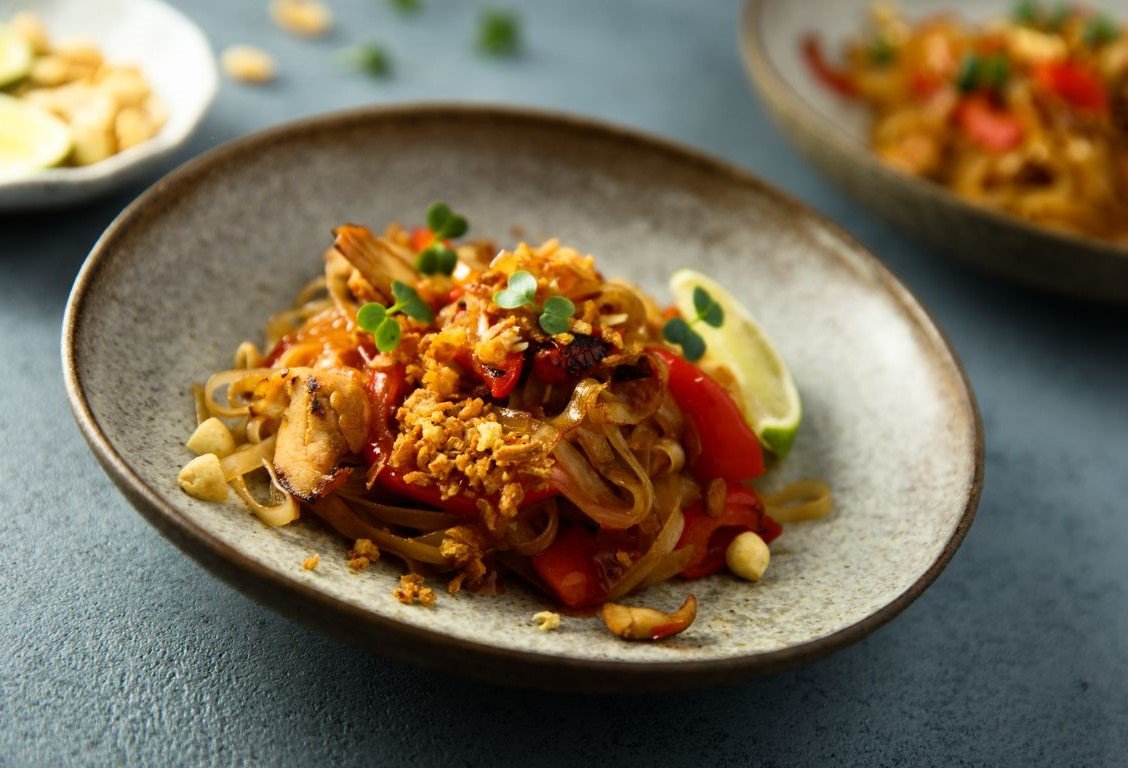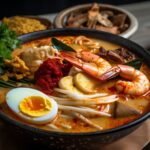Introduction to Pad Thai
Pad Thai is a quintessential Thai street food that has garnered global recognition and admiration for its unique combination of flavors and textures. This beloved dish is said to have originated in the 1930s in Thailand, coinciding with an effort by the then-prime minister to promote national identity and pride. As a result, Pad Thai was adopted as an emblematic food, encapsulating the essence of Thai cuisine while appealing to both local and foreign palates. Its rich history and cultural significance transform every serving of Pad Thai into a celebration of culinary tradition.
What sets Pad Thai apart is its intricate balance of sweet, sour, salty, and spicy elements, a hallmark of many Thai dishes. The foundation of Pad Thai lies in its main components: pad thai noodles, which are flat rice noodles, light and chewy, serving as the canvas for this delectable meal. The dish is typically stir-fried with a variety of ingredients, including eggs, tofu, shrimp, or chicken, ensuring there’s something to delight every food lover. Moreover, the addition of fresh bean sprouts, peanuts, and green onions contributes delightful texture and flavor, making each bite a sensory experience.
Furthermore, the enchanting pad thai sauce is crucial in defining the dish’s character. Often made from tamarind paste, fish sauce, sugar, and lime juice, this sauce elegantly melds the flavors together, allowing for a symphony of tastes in each serving. The cultural significance of Pad Thai has transcended borders, evolving from its street food roots into a staple of Thai restaurants worldwide, prompting food enthusiasts to seek authentic recipes to replicate its essence at home. Through its diverse ingredients and flavors, Pad Thai continues to be a testament to Thailand’s rich culinary heritage.
Essential Ingredients for Pad Thai

Creating an authentic Pad Thai requires a careful selection of ingredients, each contributing to the dish’s unique flavor profile and texture. The core components can be categorized into five groups: noodles, proteins, vegetables, sauces, and garnishes. Understanding these ingredients is crucial for replicating a true Pad Thai experience at home.
Firstly, the Pad Thai noodles are the heart of the dish. These rice noodles, typically flat and wide, are essential for achieving the right texture. If unavailable, substitutes such as soba or linguine can be considered, but they may alter the dish’s authenticity. When selecting noodles, look for ones labeled specifically for ‘Pad Thai’ to ensure proper consistency when cooked.
Next are the proteins, which usually include shrimp, chicken, or tofu, offering a variety of flavors and textures. Each choice can significantly influence the dish. For instance, shrimp adds a sweet, briny flavor, while tofu caters to vegetarian diets, providing a hearty base that absorbs the Pad Thai sauce beautifully. For those with dietary restrictions, tempeh or seitan can also serve as adequate substitutes.
Vegetables play a crucial role in enhancing both the taste and nutrition of Pad Thai. Traditional ingredients like bean sprouts, scallions, and garlic chives are essential. However, you can adjust according to personal preference or what’s in season. Other vegetables, such as bell peppers or carrots, can add color and crunch but may deviate from the traditional recipe.
The Pad Thai sauce is another important element, usually made from tamarind paste, fish sauce, sugar, and lime juice. This combination creates the dish’s signature tangy and savory profile. For a vegetarian version, consider using soy sauce or coconut aminos as a substitute. Finally, garnishes such as crushed peanuts and lime wedges not only enhance presentation but contribute additional flavors that complete the meal.
Step-by-Step Cooking Instructions

To create an authentic Pad Thai, it is essential to start with the right preparations. Begin by soaking the Pad Thai noodles in warm water for about 30 minutes until they soften. This step is crucial, as properly soaked noodles will yield the perfect texture. Meanwhile, chop your choice of vegetables such as bean sprouts, green onions, and bell peppers, ensuring they are ready to be incorporated into the dish.
Next, heat a tablespoon of vegetable oil in a large skillet or wok over medium-high heat. If you are using proteins such as shrimp, chicken, or tofu, sauté them first until they are fully cooked, which should take around 3-5 minutes. Remove the cooked proteins from the skillet and set them aside. In the same skillet, add an extra tablespoon of oil along with the chopped vegetables. Stir-fry them for 2-3 minutes until they become slightly tender yet still crisp.
Once your vegetables are ready, it is time to incorporate the Pad Thai noodles. Drain the softened noodles and add them to the skillet, stirring gently to avoid breaking them. After a minute, pour in your pre-prepared Pad Thai sauce. This sauce, which typically combines tamarind paste, fish sauce, sugar, and lime, is the heart of your dish. Toss everything together continuously for about 2-3 minutes, ensuring that the noodles are evenly coated in the sauce.
Return the cooked proteins to the skillet and mix them in with the noodles and vegetables. This stage should take no longer than 2 minutes. Finally, remove the skillet from heat and garnish your Pad Thai with crushed peanuts, fresh cilantro, and lime wedges for an added burst of flavor. Following these detailed steps will ensure a vibrant and flavorful pad thai that is appealing in both taste and presentation.
Tips and Variations for Perfect Pad Thai
Creating the ideal Pad Thai involves not only following the recipe but also incorporating expert tips and making creative variations. A fundamental aspect of this dish is the balance of flavors, which can be customized based on personal preferences. Start by adjusting the spice levels to suit your taste. If you prefer a milder flavor, use less chili powder or omit the crushed peanuts altogether. Conversely, for those who enjoy heat, consider adding fresh sliced bird’s eye chilies or a dash of sriracha to the Pad Thai sauce for an extra kick.
Protein options in Pad Thai are versatile. Traditional recipes often feature shrimp; however, alternatives like chicken or tofu can make the dish suitable for various dietary preferences. When using tofu, opt for firm varieties and press them to remove excess moisture before cubing and sautéing. This ensures they absorb the Pad Thai sauce better. If you’re considering a vegetarian version, include a mix of protein-rich vegetables such as edamame or mushrooms alongside your pad thai noodles.
Vegetables play a crucial role in the aesthetic and nutritional balance of Pad Thai. Incorporating fresh ingredients such as bean sprouts, scallions, and bell peppers not only enhances the flavor but also adds a vibrant crunch. For a visually appealing presentation, arrange the Pad Thai on a plate, top it with a sprinkle of chopped peanuts and fresh cilantro, and serve lime wedges on the side for an added burst of flavor.
When preparing this iconic dish, it is essential to avoid common mistakes. Overcooking the pad thai noodles can result in a mushy texture, so ensure they are al dente before combining with other ingredients. Additionally, be mindful of the sauce’s proportion; too much can overpower the dish, while too little can render it bland. By following these tips and experimenting with variations, you can create a personalized Pad Thai that satisfies your culinary cravings and impresses your guests.


